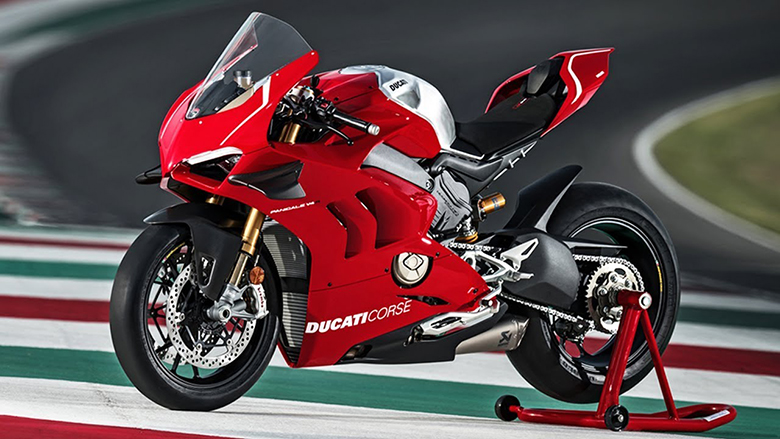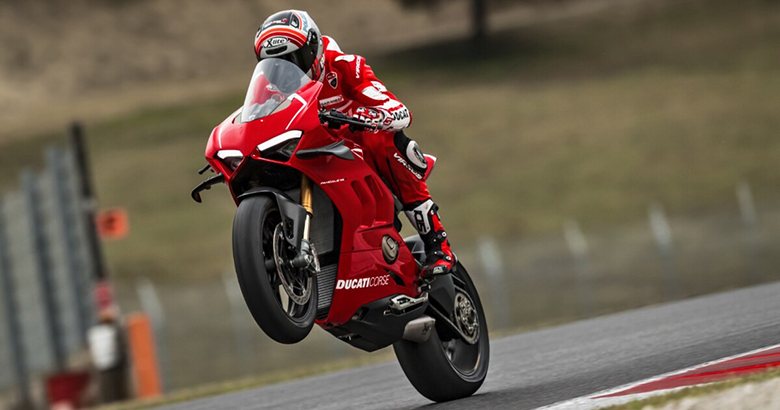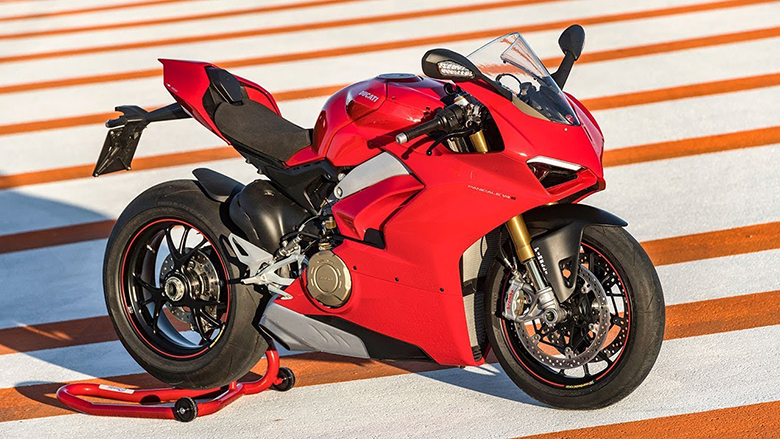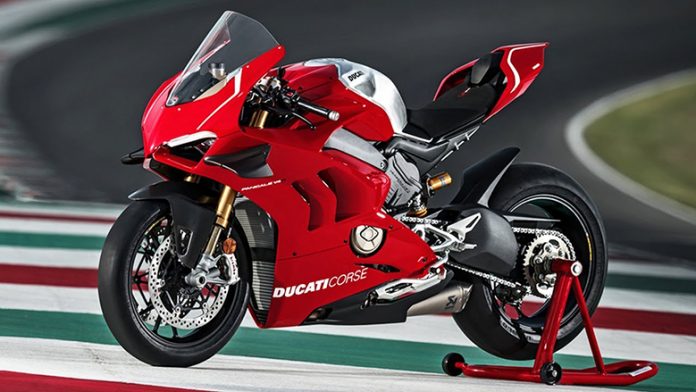The Panigale V4 R has MotoGP-derived technology and is substantially more specialized than previous R versions. Ducati Corse worked together with the Ducati Style Center to design and build a new fairing for the bike to boost aerodynamic efficiency. The redesigned fairing has aerofoil appendages developed for MotoGP prototypes. Reducing electronic controls and increasing rider stability during the journey are two benefits of using carbon fiber aero-foils. As a result of the Panigale V4 R, Ducati will field official Superbikes in the World Championship beginning in 2019. It’s a WSBK racing bike that can ride on public roads.
2019 Ducati Panigale V4 R Sports Bike – Features and Specs

New Ducati V4 Engine
The 90-degree V4 engine design is regarded by Ducati as the pinnacle of motorcycle engine performance, according to the company. In MotoGP, Desmosedici engines employ the same solution. It is not a coincidence. It is well-known that using a countershaft to balance first-order forces would increase weight and reduce power consumption, but the 90-degree V arrangement naturally balances first-order energies. For an engine with a maximum rev limit of 14,000 rpm, this is only one of several benefits of the design chosen by Ducati.
Compared to a four-cylinder in-line, the V design offers better mass centralization and reduces the bike’s frontal cross-section. Gyroscopic influence is thus decreased to a lower degree. While all of these elements are considered, the motorcycle’s agility improves, making it lighter and more responsive when changing directions. Because of the airbox’s 12.8-liter capacity and the water pump’s considerable space inside the V, the Desmosedici Stradale can take a deep breath.
An integrated engine and chassis setup is the foundation of every Ducati. The Desmosedici Stradale has been designed to be banked back 42 degrees to imitate the Ducati MotoGP engines. Improved weight distribution and more room for larger radiators may be achieved by positioning the swingarm pivot as far forward as possible.
The Desmosedici Stradale is also a part of the chassis’ structural framework. For the main chassis construction, cylinder heads from the front and rear have been mounted in the top part of the crankcase. As an additional benefit, the crankcase doubles as a mounting point for the rear suspension and swingarm.
Light and Compact
The partnership with Ducati Corse has resulted in a light, compact, and powerful engine that is small and powerful. The engine team at Ducati has worked hard to create a power delivery system that is both fun to ride on the road and fast on the track.
The Desmosedici Stradale, although being 2.2 kg heavier than the 1,285cc Superquadro twin, displays Ducati’s devotion to lightweight. Using gravity die-cast aluminum engine shells, the engine is assembled horizontally. The top of the crankcase houses the four Nikasil-coated aluminum cylinder liners, which protect against wear and minimize friction.

The 81 mm pistons have two low-attrition compression rings and an oil ring that move inside the liners. By including skirt height and below-chamber thickness, “box in box”-style molded aluminum pistons reduce attrition and inertial loads without sacrificing required strength or stiffness.
The bike’s racing-inspired construction is further shown by its compression ratio of 14:1. The crankshaft is connected with the pistons by forged steel con rods with a center-to-center distance of 101.8 mm.
Crankshafts placed on brass bushings and rotating on three supports are standard on MotoGP Desmosedici engines. The crankpins have been machined twice and are offset by 70 degrees. They are made of nitride steel.
The unusual “Twin Pulse” ignition sequence is made feasible by the V engine’s layout and the shaft’s distinctive form. Die-cast magnesium is utilized in all engine casings to save weight. The same material makes the cam covers, oil sump, alternator cover, and two-piece clutch cover.
Twin Pulse Ignition
Combining a 70-degree crankpin offset with a 90-degree V layout implies “Twin Pulse” for Ducati since the firing sequence replicates the pattern of two-cylinder engines. This cannon may readily be identified by the proximity of the two left-hand and two right-hand cylinders while firing. 0°, 90°, 290°, and 380° are the timing chart’s ignition points. The V4’s exhaust note is reminiscent of a MotoGP Desmosedici due to the way it fires.
A bike that starts at zero degrees fires the alternator’s front-most cylinder. After just a 90-degree turn, the rear cylinder on the same side begins to glow. After then, the engine does not create any driving torque until the clutch side’s two cylinders fire at 90° intervals. Dual pulse ignition delivers a power delivery that Ducati MotoGP riders consider as unrivaled because it generates exceptional engine performance and, as a result, a smoother ride, especially in corners and out of the corner sections of the track.

Variable Intake System
It is a first for a Ducati engine since the Desmosedici Stradale has four oval throttle bodies (equal to 52 mm in diameter). With this method, cylinder intake is optimized across the rpm range, enhancing both power delivery and vehicle control.
The air intake horns may be modified to lengthen or shorten the ducts depending on the engine speed and the amount of power sought by the rider.
Fixed throttle body and electric motor horn are part of a system regulated by the ECU, which controls both. Upon contact with a shorter horn, it is geometrically extended. During the engine’s lift, just the lower horn and a very short duct are fluid dynamics.
Each throttle body has a sub-butterfly injector for low-load use and an upper-butterfly injector for peak engine performance. There is a separate electric motor for each cylinder bank, which moves the throttle bodies. The Ride by Wire technology allows for complex electrical control systems and engine ‘feel’ adjustment.
Cooling System
The water pump in the engine “V” is propelled by a gear train and a shaft. This placement method reduces circuit size, improves efficiency, and reduces engine weight.

2019 Ducati Panigale V4 R Sports Bike – Technical Specifications
Engine
| Type | Desmosedici Stradale 90-degree V4, rearward-rotating crankshaft, 4 Desmodromically |
| Displacement | 998 cc |
| Bore X stroke | 81 mm x 48.4 mm |
| Compression ratio | 14.0:1 |
| Power | 162 kW (221 hp) at 15,250 rpm |
| Torque | 112 Nm (83 lb-ft) at 11,500 rpm |
| Fuel injection | Electronic fuel injection system. Twin injectors per cylinder. Entire ride-by-wire elliptical throttle bodies with aerodynamic valves. The variable-length intake system |
| Exhaust | 4-2-1-2 system, having two catalytic converters and two lambda probes |
| Gearbox | Six-speed with Ducati Quick Shift (DQS) up/down EVO |
| Primary drive | Straight cut gears; Ratios 1.80:1 |
| Final drive | Chain; Front sprocket 15; Rear sprocket 42 |
| Clutch | Hydraulically controlled slipper & self-servo wet multi-plate clutch |
Chassis
| Frame | Aluminum alloy “Front Frame” with optimized stiffnesses |
| Front suspension | Fully adjustable 43 mm Öhlins NPX pressurized fork with TiN treatment. |
| Front-wheel | 3-spokes forged aluminum alloy 3.50-inch x 17-inch |
| Front tire | Pirelli Diablo Supercorsa SP 120/70 ZR17 |
| Rear Suspension | Fully adjustable Ohlins TTX36 unit. Aluminum single-sided swingarm. Adjustable pivot position +/- 3 mm |
| Rear Wheel | 3-spokes forged aluminum alloy 6-inch x 17-inch |
| Rear tire | Pirelli Diablo Supercorsa SP 200/60 ZR17 |
| Wheel travel (front/rear) | 120mm (4.7 inches) – 130mm (5.1 inches) |
| Front brake | 2 x 330mm semi-floating discs with radially fixed Brembo Monobloc Stylema (M4.30) 4-piston calipers with Bosch Cornering ABS EVO |
| Rear brake | 245mm disc, 2-piston caliper having Bosch Cornering ABS EVO |
| Instrumentation | Last generation digital unit with 5-inch TFT color display |
Dimension
| Dry weight | 172 kg (379 lb) |
| Curb weight | 193 kg (425 lb) |
| Seat height | 830 mm (32.7 inches) |
| Wheelbase | 1.471mm (57.9 inches) |
| Rake | 24,5° |
| Front-wheel trail | 100 mm (3.94 inches) |
| Fuel tank capacity | 16 l – 4.23 gallon (US) |
| Number of seats | Single-seat |
Others
| Safety equipment | Riding Modes, Power Modes, Bosch Cornering ABS EVO, Ducati Traction Control (DTC) EVO, Ducati Wheelie Control (DWC) EVO, Ducati Slide Control (DSC), Engine Brake Control (EBC) EVO, Auto tire calibration |
| Standard equipment | Ducati Power Launch (DPL), Ducati Quick Shift (DQS) up/down EVO, Full LED lighting with Daytime Running Light (DRL), GPS module, Lap Timer EVO, PIT limiter, Ohlins steering damper, Quick adjustment buttons, Lithium-ion battery, Auto-off indicators, Marchesini aluminum forged wheels, Carbon fiber heatshield and front mudguard, High-flow air filter |
| Additional equipment | Machined mirror block-off plates, License plate mount removal plug, Ducati Data Analyser+ (DDA+) |
| Ready for | Ducati Multimedia System (DMS) and anti-theft |
| Warranty (months) | 24 months unlimited mileage |
| Maintenance (km/months) | 12,000 km (7,500 mi) / 12 months |
| Valve clearance adjustment (km) | 24,000 km (15,000 mi) |
| Standard | Euro 4 |
| Consumption | Consumption =7,3 l/100km |
| CO2 Emissions | CO2 = 175 g/km |

